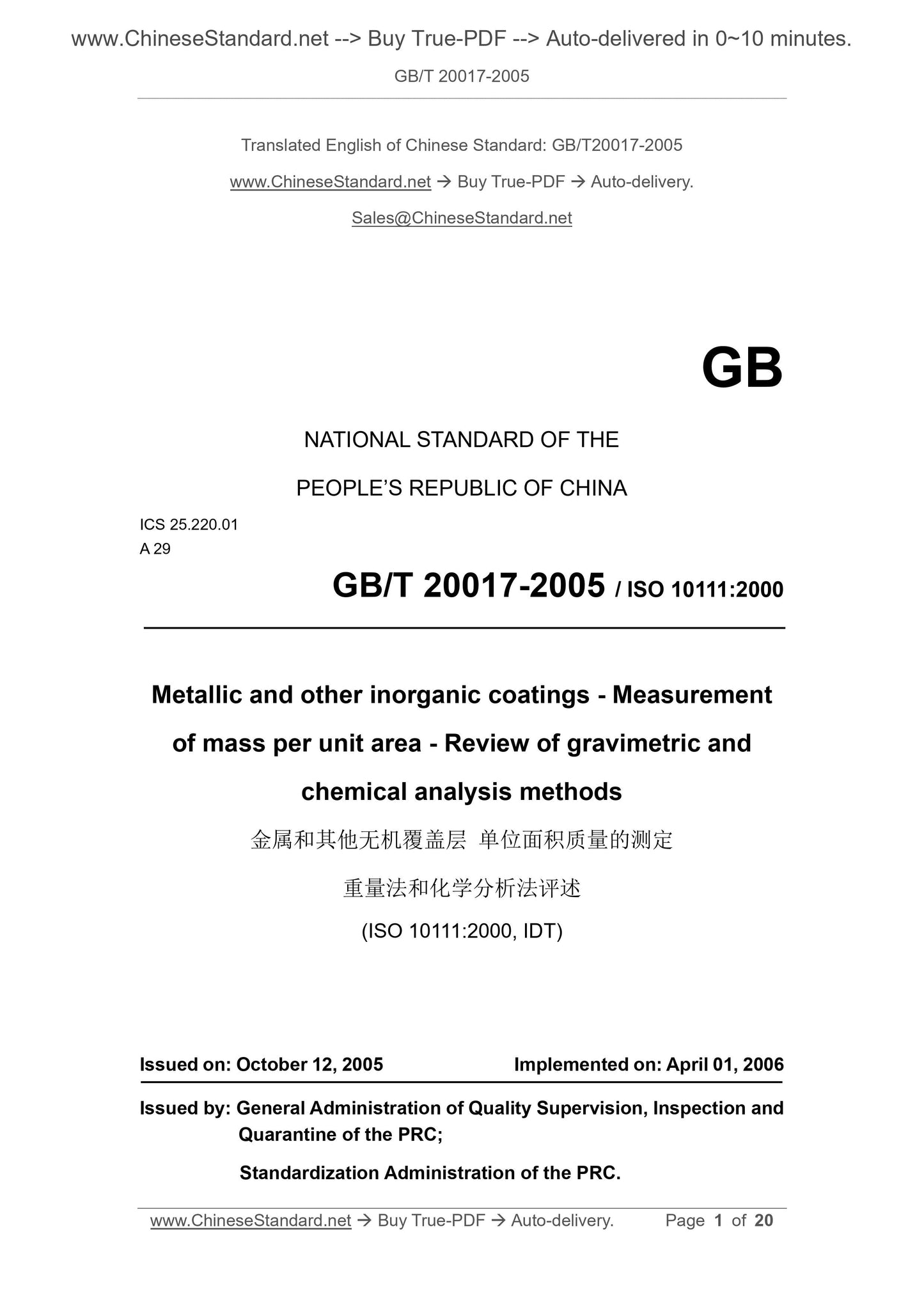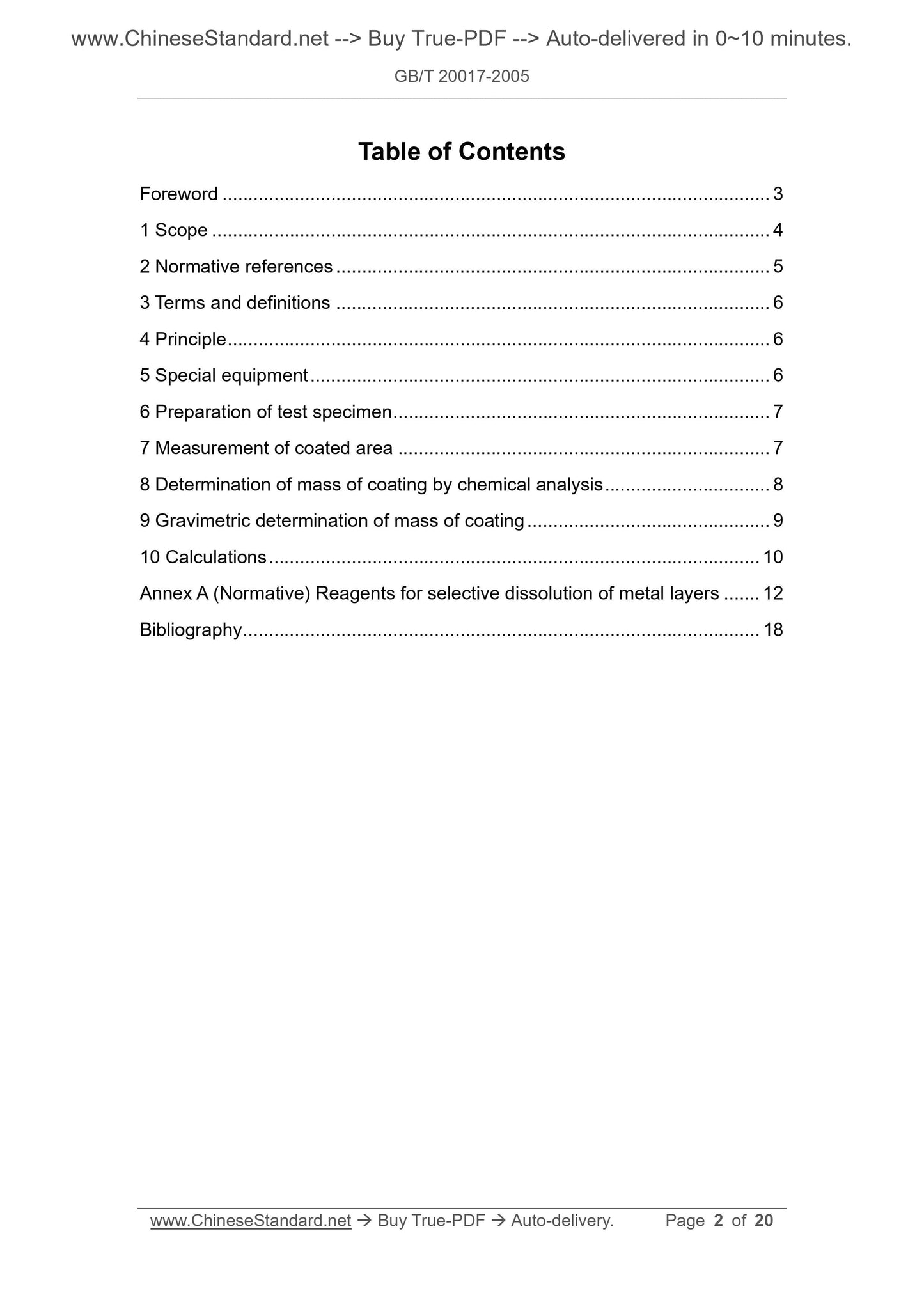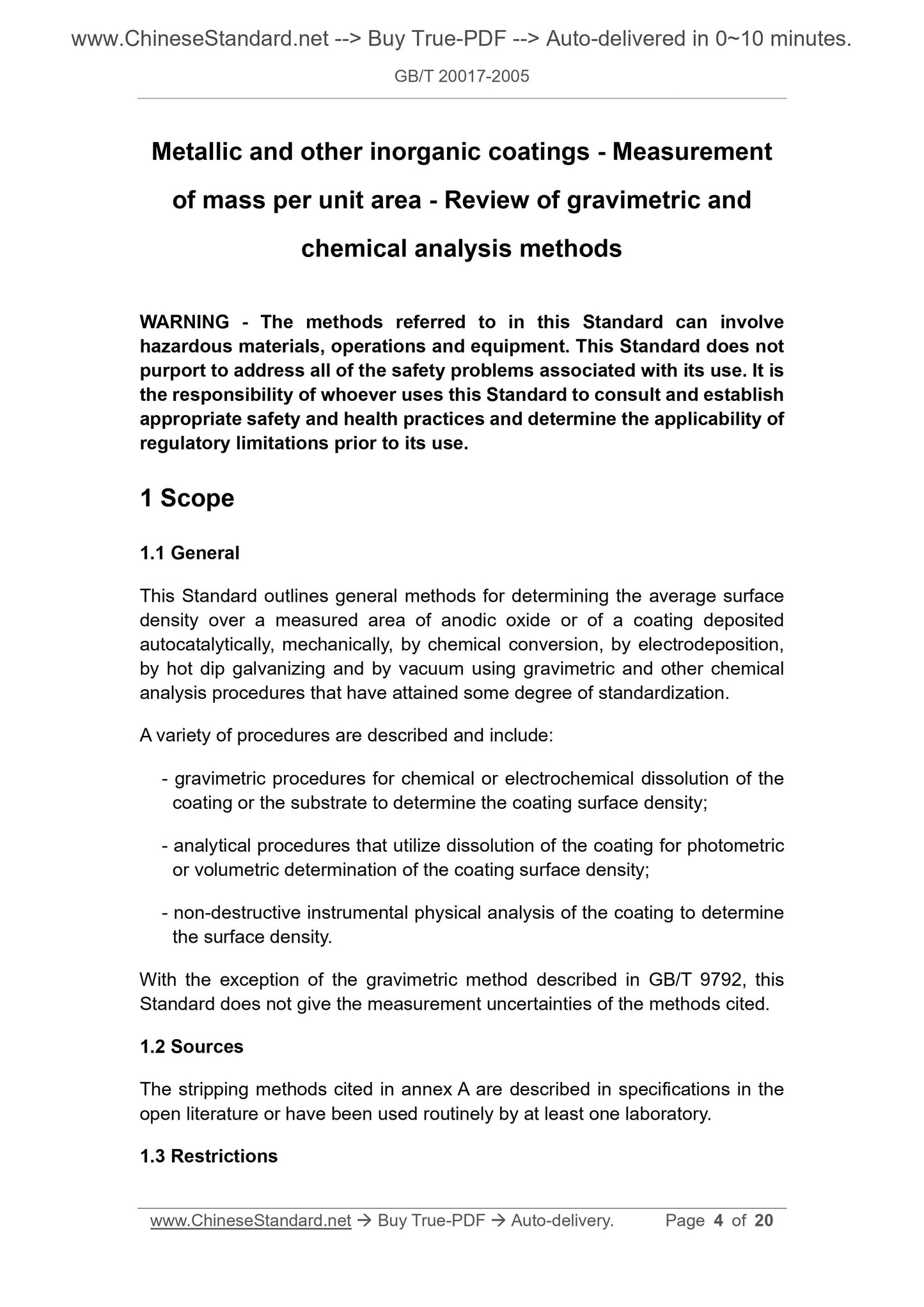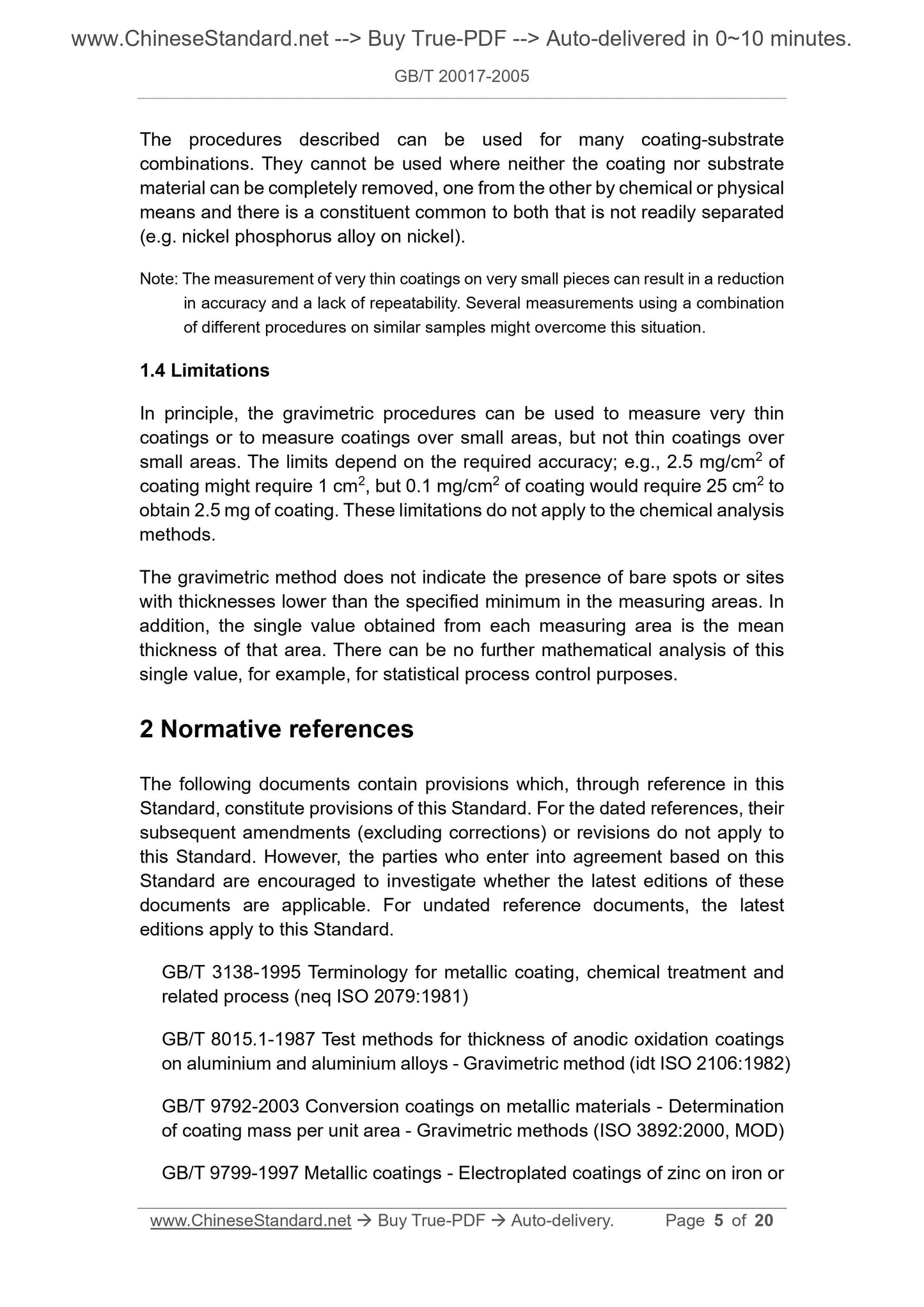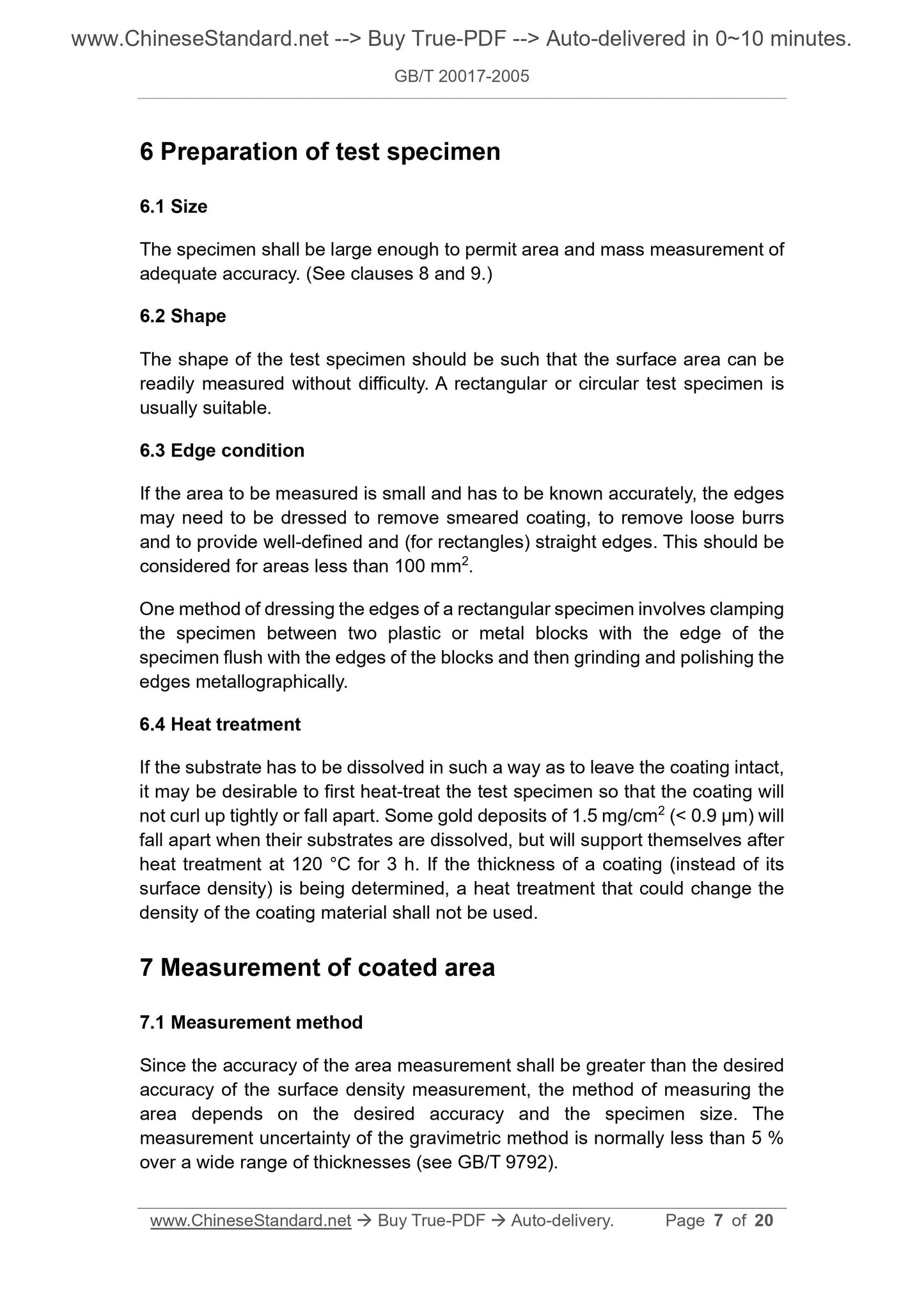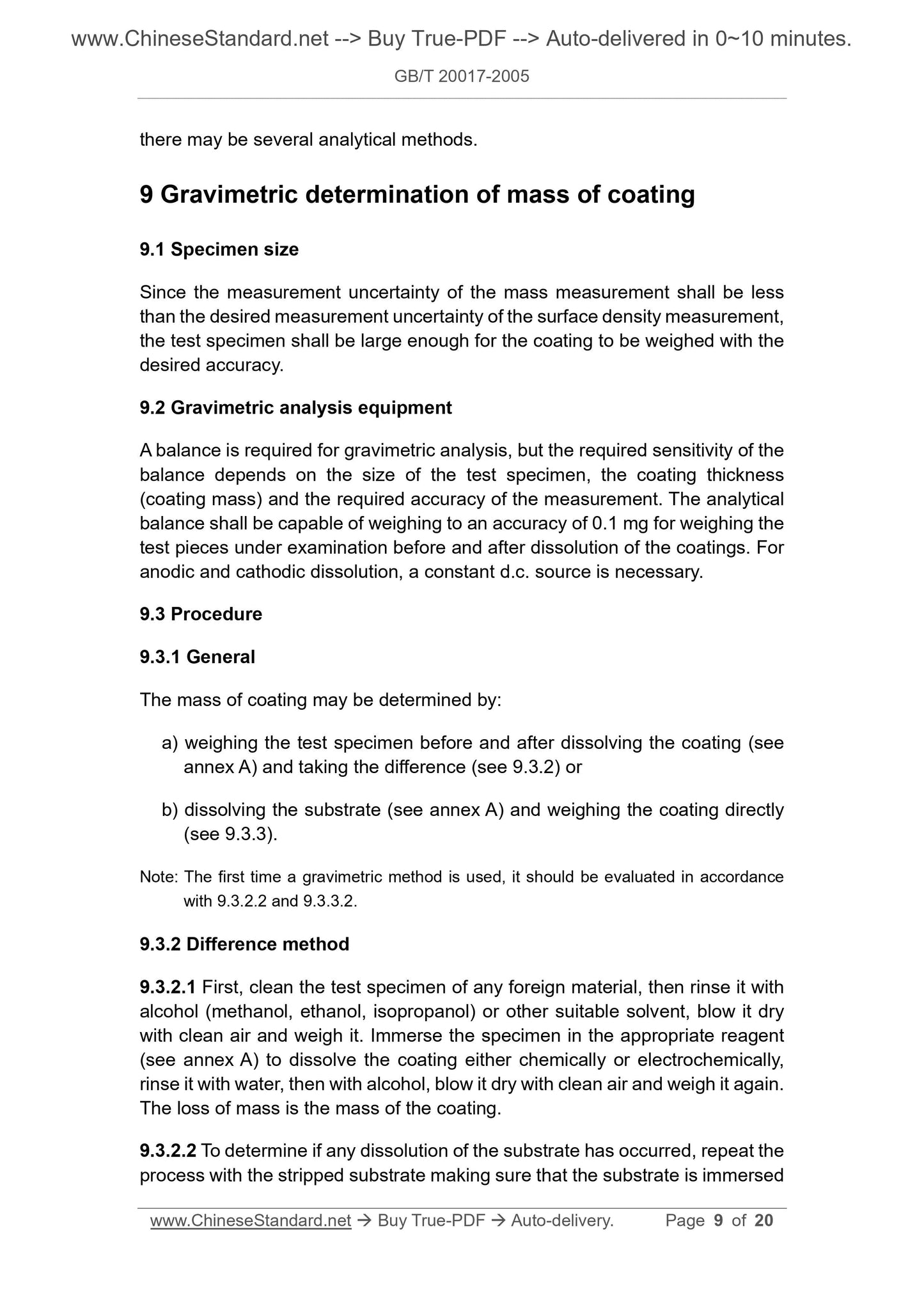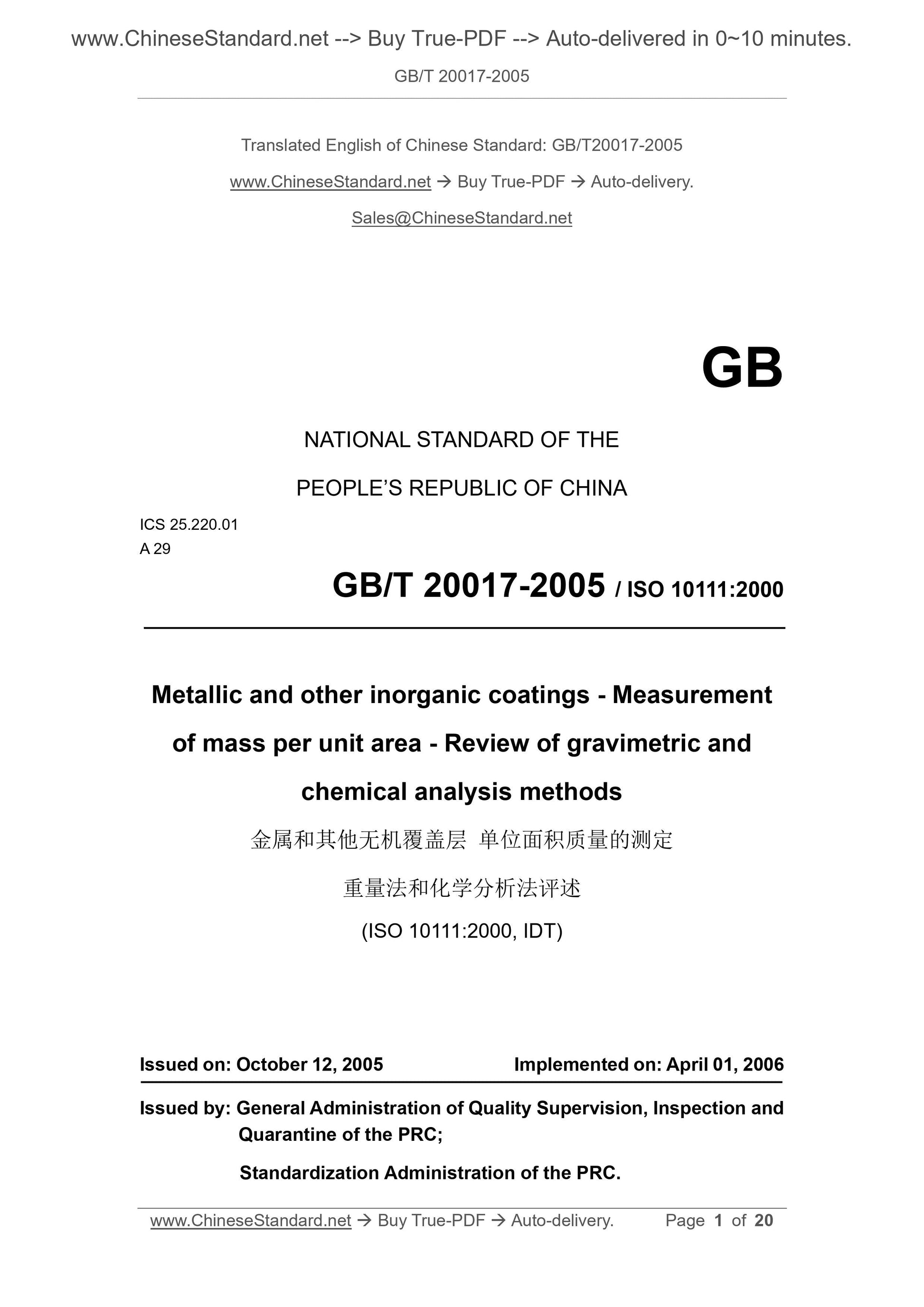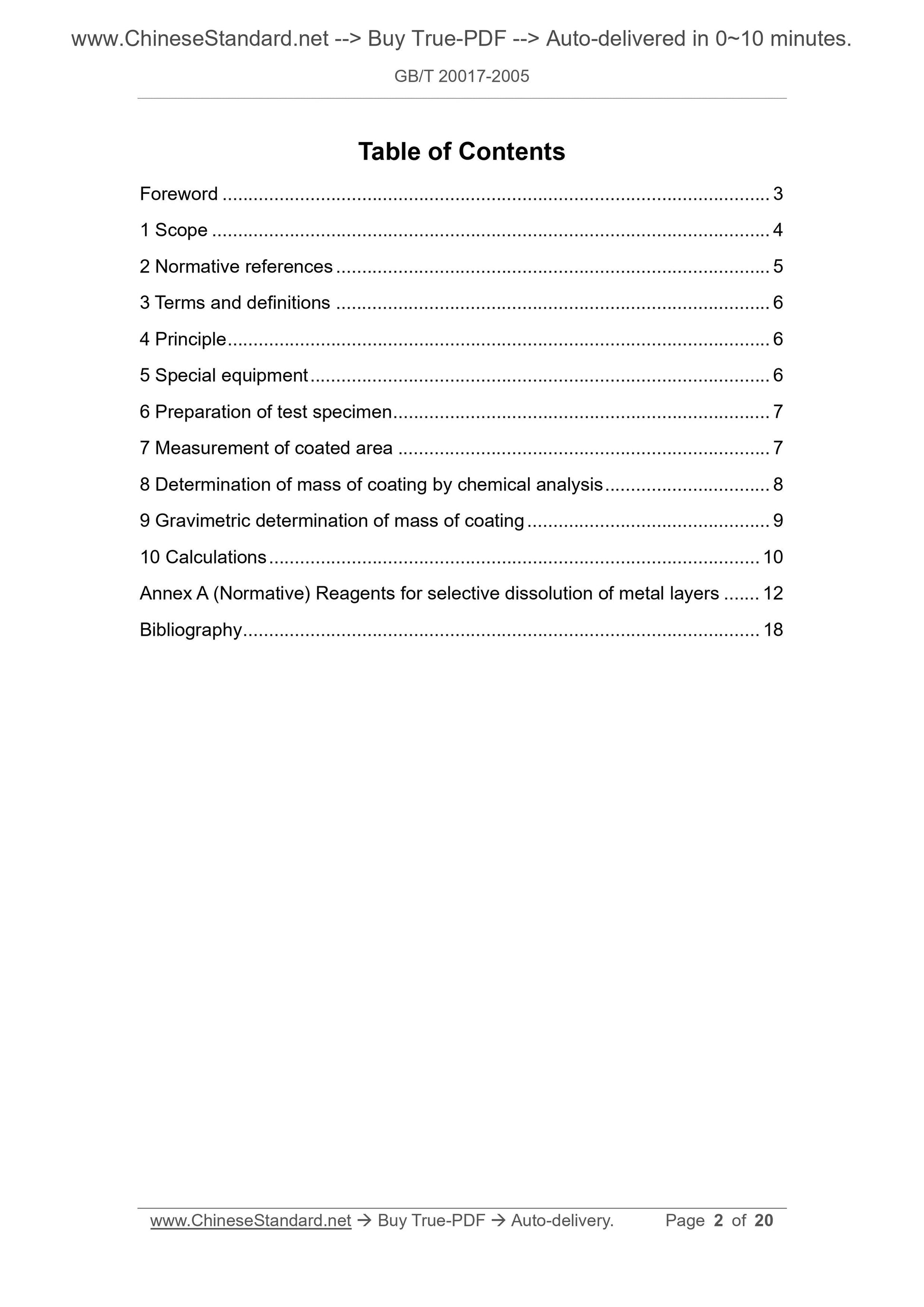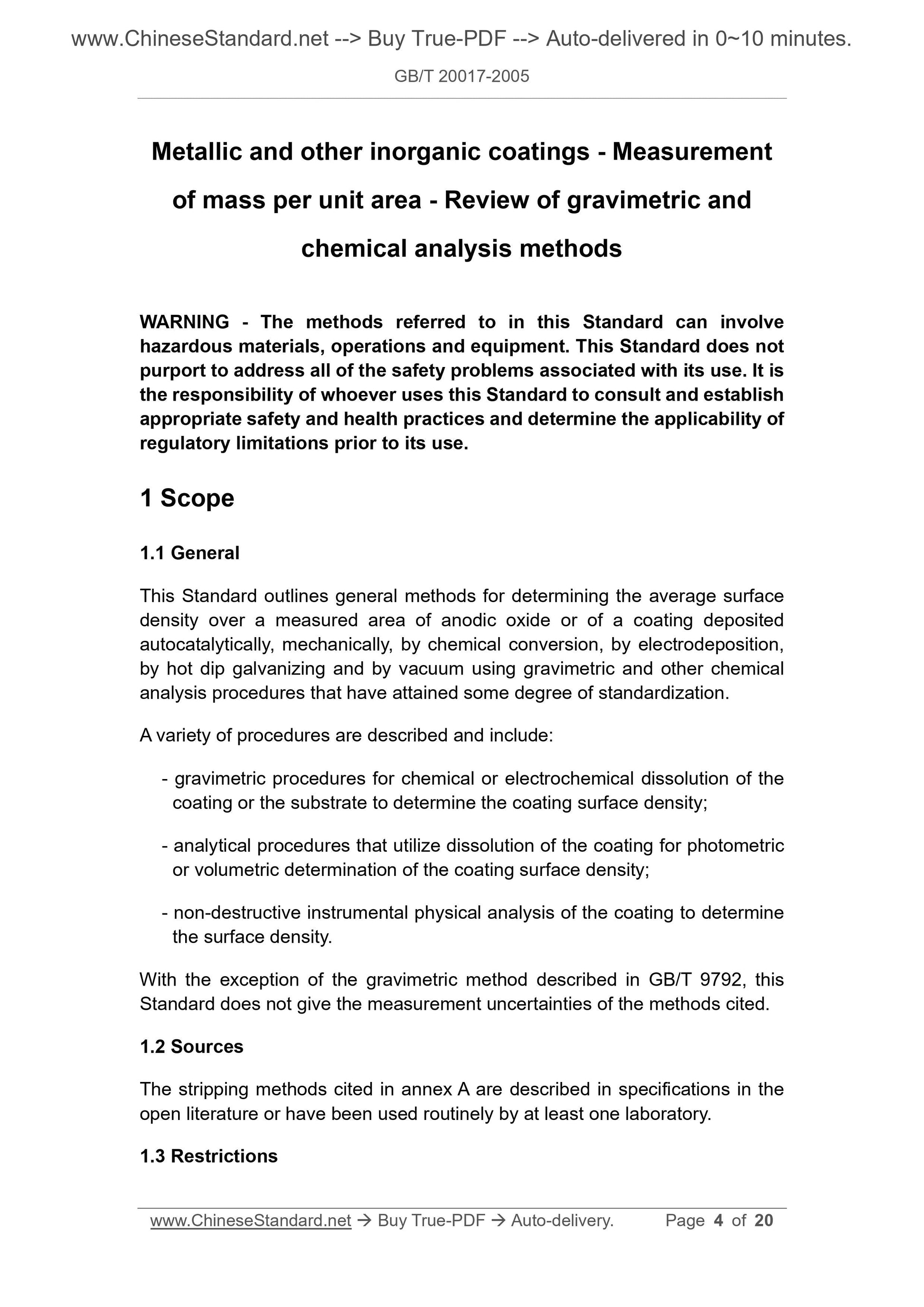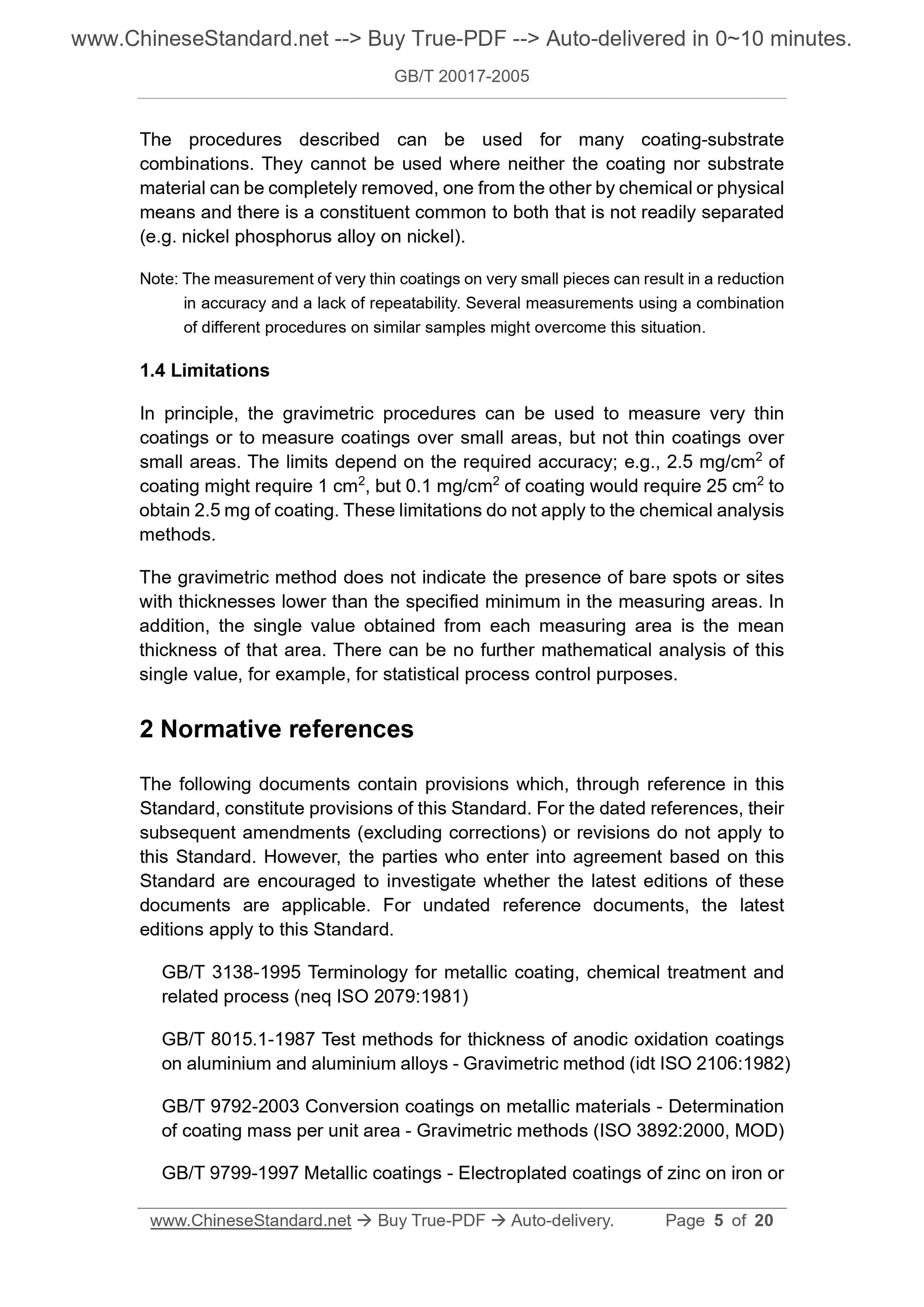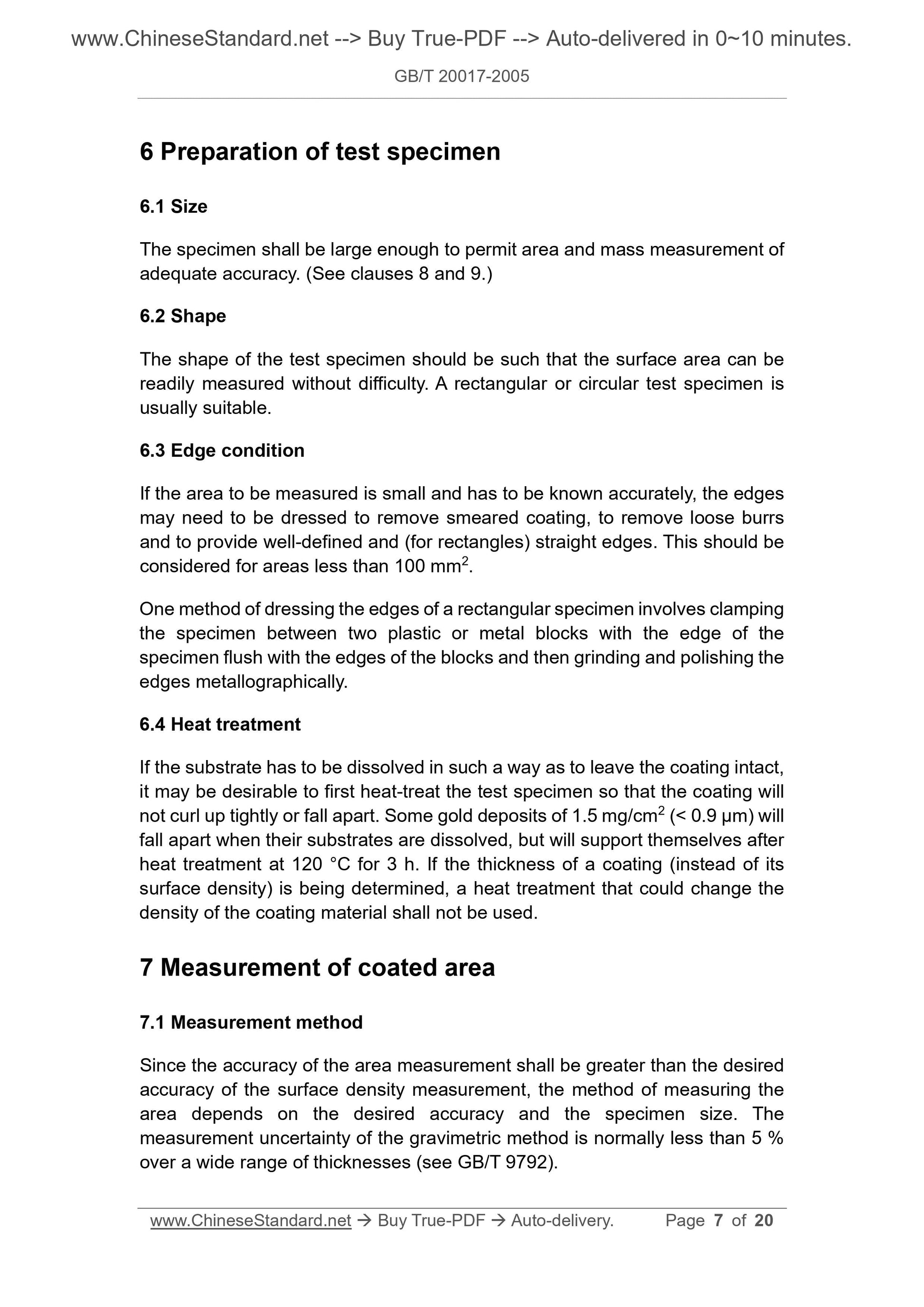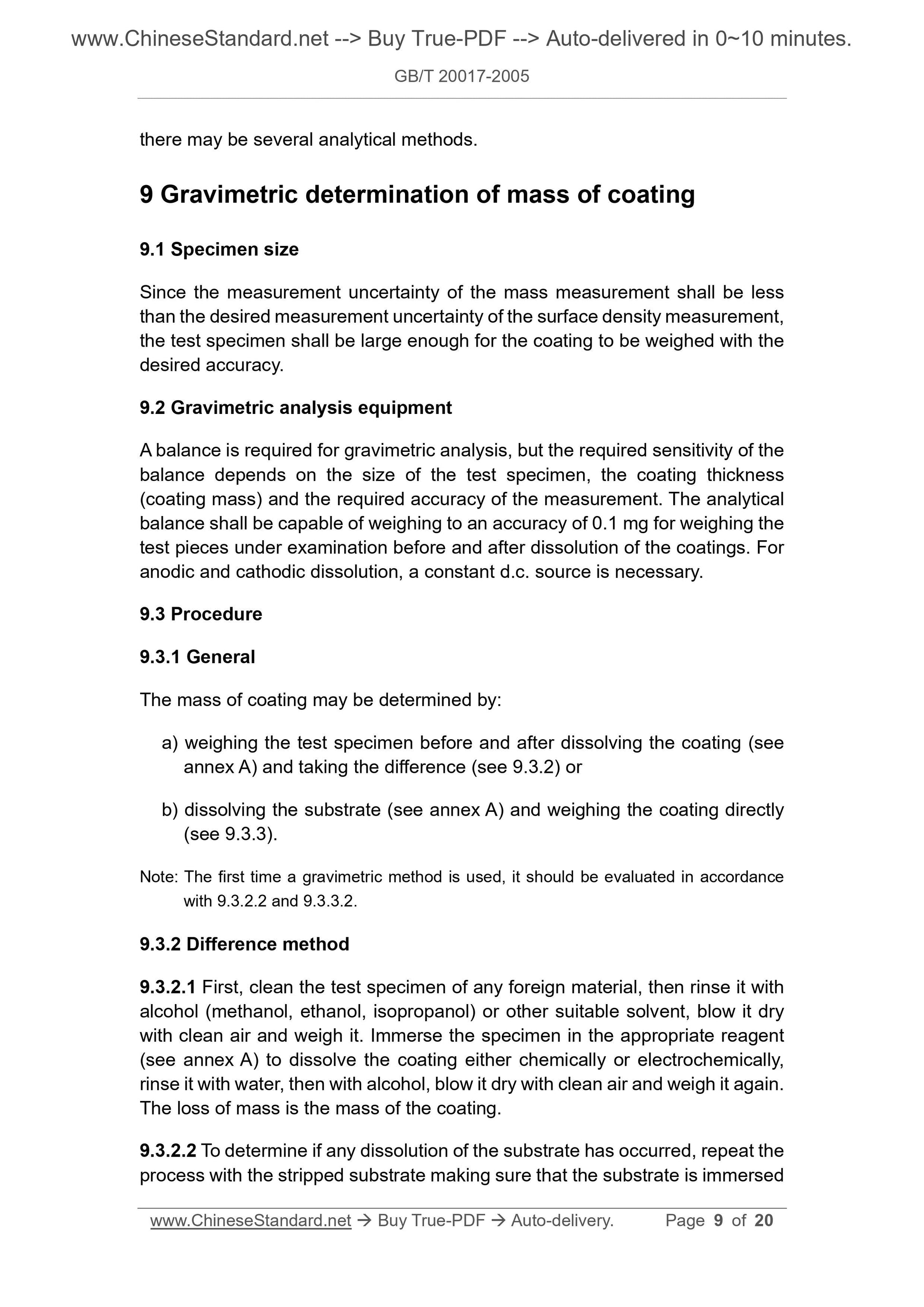1
/
of
6
www.ChineseStandard.us -- Field Test Asia Pte. Ltd.
GB/T 20017-2005 English PDF (GB/T20017-2005)
GB/T 20017-2005 English PDF (GB/T20017-2005)
Regular price
$185.00
Regular price
Sale price
$185.00
Unit price
/
per
Shipping calculated at checkout.
Couldn't load pickup availability
GB/T 20017-2005: Metallic and other inorganic coatings -- Measurement of mass per unit area -- Review of gravimetric and chemical analysis methods
Delivery: 9 seconds. Download (& Email) true-PDF + Invoice.
Get Quotation: Click GB/T 20017-2005 (Self-service in 1-minute)
Historical versions (Master-website): GB/T 20017-2005
Preview True-PDF (Reload/Scroll-down if blank)
GB/T 20017-2005
NATIONAL STANDARD OF THE
PEOPLE’S REPUBLIC OF CHINA
ICS 25.220.01
A 29
GB/T 20017-2005 / ISO 10111:2000
Metallic and other inorganic coatings - Measurement
of mass per unit area - Review of gravimetric and
chemical analysis methods
(ISO 10111:2000, IDT)
ISSUED ON: OCTOBER 12, 2005
IMPLEMENTED ON: APRIL 01, 2006
Issued by: General Administration of Quality Supervision, Inspection and
Quarantine of the PRC;
Standardization Administration of the PRC.
Table of Contents
Foreword ... 3
1 Scope ... 4
2 Normative references ... 5
3 Terms and definitions ... 6
4 Principle ... 6
5 Special equipment ... 6
6 Preparation of test specimen ... 7
7 Measurement of coated area ... 7
8 Determination of mass of coating by chemical analysis ... 8
9 Gravimetric determination of mass of coating ... 9
10 Calculations ... 10
Annex A (Normative) Reagents for selective dissolution of metal layers ... 12
Bibliography ... 18
Metallic and other inorganic coatings - Measurement
of mass per unit area - Review of gravimetric and
chemical analysis methods
WARNING - The methods referred to in this Standard can involve
hazardous materials, operations and equipment. This Standard does not
purport to address all of the safety problems associated with its use. It is
the responsibility of whoever uses this Standard to consult and establish
appropriate safety and health practices and determine the applicability of
regulatory limitations prior to its use.
1 Scope
1.1 General
This Standard outlines general methods for determining the average surface
density over a measured area of anodic oxide or of a coating deposited
autocatalytically, mechanically, by chemical conversion, by electrodeposition,
by hot dip galvanizing and by vacuum using gravimetric and other chemical
analysis procedures that have attained some degree of standardization.
A variety of procedures are described and include:
- gravimetric procedures for chemical or electrochemical dissolution of the
coating or the substrate to determine the coating surface density;
- analytical procedures that utilize dissolution of the coating for photometric
or volumetric determination of the coating surface density;
- non-destructive instrumental physical analysis of the coating to determine
the surface density.
With the exception of the gravimetric method described in GB/T 9792, this
Standard does not give the measurement uncertainties of the methods cited.
1.2 Sources
The stripping methods cited in annex A are described in specifications in the
open literature or have been used routinely by at least one laboratory.
1.3 Restrictions
The procedures described can be used for many coating-substrate
combinations. They cannot be used where neither the coating nor substrate
material can be completely removed, one from the other by chemical or physical
means and there is a constituent common to both that is not readily separated
(e.g. nickel phosphorus alloy on nickel).
Note: The measurement of very thin coatings on very small pieces can result in a reduction
in accuracy and a lack of repeatability. Several measurements using a combination
of different procedures on similar samples might overcome this situation.
1.4 Limitations
In principle, the gravimetric procedures can be used to measure very thin
coatings or to measure coatings over small areas, but not thin coatings over
small areas. The limits depend on the required accuracy; e.g., 2.5 mg/cm2 of
coating might require 1 cm2, but 0.1 mg/cm2 of coating would require 25 cm2 to
obtain 2.5 mg of coating. These limitations do not apply to the chemical analysis
methods.
The gravimetric method does not indicate the presence of bare spots or sites
with thicknesses lower than the specified minimum in the measuring areas. In
addition, the single value obtained from each measuring area is the mean
thickness of that area. There can be no further mathematical analysis of this
single value, for example, for statistical process control purposes.
2 Normative references
The following documents contain provisions which, through reference in this
Standard, constitute provisions of this Standard. For the dated references, their
subsequent amendments (excluding corrections) or revisions do not apply to
this Standard. However, the parties who enter into agreement based on this
Standard are encouraged to investigate whether the latest editions of these
documents are applicable. For undated reference documents, the latest
editions apply to this Standard.
GB/T 3138-1995 Terminology for metallic coating, chemical treatment and
related process (neq ISO 2079:1981)
GB/T 8015.1-1987 Test methods for thickness of anodic oxidation coatings
on aluminium and aluminium alloys - Gravimetric method (idt ISO 2106:1982)
GB/T 9792-2003 Conversion coatings on metallic materials - Determination
of coating mass per unit area - Gravimetric methods (ISO 3892:2000, MOD)
GB/T 9799-1997 Metallic coatings - Electroplated coatings of zinc on iron or
6 Preparation of test specimen
6.1 Size
The specimen shall be large enough to permit area and mass measurement of
adequate accuracy. (See clauses 8 and 9.)
6.2 Shape
The shape of the test specimen should be such that the surface area can be
readily measured without difficulty. A rectangular or circular test specimen is
usually suitable.
6.3 Edge condition
If the area to be measured is small and has to be known accurately, the edges
may need to be dressed to remove smeared coating, to remove loose burrs
and to provide well-defined and (for rectangles) straight edges. This should be
considered for areas less than 100 mm2.
One method of dressing the edges of a rectangular specimen involves clamping
the specimen between two plastic or metal blocks with the edge of the
specimen flush with the edges of the blocks and then grinding and polishing the
edges metallographically.
6.4 Heat treatment
If the substrate has to be dissolved in such a way as to leave the coating intact,
it may be desirable to first heat-treat the test specimen so that the coating will
not curl up tightly or fall apart. Some gold deposits of 1.5 mg/cm2 (< 0.9 μm) will
fall apart when their substrates are dissolved, but will support themselves after
heat treatment at 120 °C for 3 h. If the thickness of a coating (instead of its
surface density) is being determined, a heat treatment that could change the
density of the coating material shall not be used.
7 Measurement of coated area
7.1 Measurement method
Since the accuracy of the area measurement shall be greater than the desired
accuracy of the surface density measurement, the method of measuring the
area depends on the desired accuracy and the specimen size. The
measurement uncertainty of the gravimetric method is normally less than 5 %
over a wide range of thicknesses (see GB/T 9792).
there may be several analytical methods.
9 Gravimetric determination of mass of coating
9.1 Specimen size
Since the measurement uncertainty of the mass measurement shall be less
than the desired measurement uncertainty of the surface density measurement,
the test specimen shall be large enough for the coating to be weighed with the
desired accuracy.
9.2 Gravimetric analysis equipment
A balance is required for gravimetric analysis, but the required sensitivity of the
balance depends on the size of the test specimen, the coating thickness
(coating mass) and the required accuracy of the measurement. The analytical
balance shall be capable of weighing to an accuracy of 0.1 mg for weighing the
test pieces under examination before and after dissolution of the coatings. For
anodic and cathodic dissolution, a constant d.c. source is necessary.
9.3 Procedure
9.3.1 General
The mass of coating may be determined by:
a) weighing the test specimen before and after dissolving the coating (see
annex A) and taking the difference (see 9.3.2) or
b) dissolving the substrate (see annex A) and weighing the coating directly
(see 9.3.3).
Note: The first time a gravimetric method is used, it should be evaluated in accordance
with 9.3.2.2 and 9.3.3.2.
9.3.2 Difference method
9.3.2.1 First, clean the test specimen of any foreign material, then rinse it with
alcohol (methanol, ethanol, isopropanol) or other suitable solvent, blow it dry
with clean air and weigh it. Immerse the specimen in the appropriate reagent
(see annex A) to dissolve the coating either chemically or electrochemically,
rinse it with water, then with alcohol, blow it dry with clean air and weigh it again.
The loss of mass is the mass of the coating.
9.3.2.2 To determine if any dissolution of the substrate has occurred, repeat the
process with the stripped substrate making sure that the substrate is immersed
GB/T 20017-2005
NATIONAL STANDARD OF THE
PEOPLE’S REPUBLIC OF CHINA
ICS 25.220.01
A 29
GB/T 20017-2005 / ISO 10111:2000
Metallic and other inorganic coatings - Measurement
of mass per unit area - Review of gravimetric and
chemical analysis methods
(ISO 10111:2000, IDT)
ISSUED ON: OCTOBER 12, 2005
IMPLEMENTED ON: APRIL 01, 2006
Issued by: General Administration of Quality Supervision, Inspection and
Quarantine of the PRC;
Standardization Administration of the PRC.
Table of Contents
Foreword ... 3
1 Scope ... 4
2 Normative references ... 5
3 Terms and definitions ... 6
4 Principle ... 6
5 Special equipment ... 6
6 Preparation of test specimen ... 7
7 Measurement of coated area ... 7
8 Determination of mass of coating by chemical analysis ... 8
9 Gravimetric determination of mass of coating ... 9
10 Calculations ... 10
Annex A (Normative) Reagents for selective dissolution of metal layers ... 12
Bibliography ... 18
Metallic and other inorganic coatings - Measurement
of mass per unit area - Review of gravimetric and
chemical analysis methods
WARNING - The methods referred to in this Standard can involve
hazardous materials, operations and equipment. This Standard does not
purport to address all of the safety problems associated with its use. It is
the responsibility of whoever uses this Standard to consult and establish
appropriate safety and health practices and determine the applicability of
regulatory limitations prior to its use.
1 Scope
1.1 General
This Standard outlines general methods for determining the average surface
density over a measured area of anodic oxide or of a coating deposited
autocatalytically, mechanically, by chemical conversion, by electrodeposition,
by hot dip galvanizing and by vacuum using gravimetric and other chemical
analysis procedures that have attained some degree of standardization.
A variety of procedures are described and include:
- gravimetric procedures for chemical or electrochemical dissolution of the
coating or the substrate to determine the coating surface density;
- analytical procedures that utilize dissolution of the coating for photometric
or volumetric determination of the coating surface density;
- non-destructive instrumental physical analysis of the coating to determine
the surface density.
With the exception of the gravimetric method described in GB/T 9792, this
Standard does not give the measurement uncertainties of the methods cited.
1.2 Sources
The stripping methods cited in annex A are described in specifications in the
open literature or have been used routinely by at least one laboratory.
1.3 Restrictions
The procedures described can be used for many coating-substrate
combinations. They cannot be used where neither the coating nor substrate
material can be completely removed, one from the other by chemical or physical
means and there is a constituent common to both that is not readily separated
(e.g. nickel phosphorus alloy on nickel).
Note: The measurement of very thin coatings on very small pieces can result in a reduction
in accuracy and a lack of repeatability. Several measurements using a combination
of different procedures on similar samples might overcome this situation.
1.4 Limitations
In principle, the gravimetric procedures can be used to measure very thin
coatings or to measure coatings over small areas, but not thin coatings over
small areas. The limits depend on the required accuracy; e.g., 2.5 mg/cm2 of
coating might require 1 cm2, but 0.1 mg/cm2 of coating would require 25 cm2 to
obtain 2.5 mg of coating. These limitations do not apply to the chemical analysis
methods.
The gravimetric method does not indicate the presence of bare spots or sites
with thicknesses lower than the specified minimum in the measuring areas. In
addition, the single value obtained from each measuring area is the mean
thickness of that area. There can be no further mathematical analysis of this
single value, for example, for statistical process control purposes.
2 Normative references
The following documents contain provisions which, through reference in this
Standard, constitute provisions of this Standard. For the dated references, their
subsequent amendments (excluding corrections) or revisions do not apply to
this Standard. However, the parties who enter into agreement based on this
Standard are encouraged to investigate whether the latest editions of these
documents are applicable. For undated reference documents, the latest
editions apply to this Standard.
GB/T 3138-1995 Terminology for metallic coating, chemical treatment and
related process (neq ISO 2079:1981)
GB/T 8015.1-1987 Test methods for thickness of anodic oxidation coatings
on aluminium and aluminium alloys - Gravimetric method (idt ISO 2106:1982)
GB/T 9792-2003 Conversion coatings on metallic materials - Determination
of coating mass per unit area - Gravimetric methods (ISO 3892:2000, MOD)
GB/T 9799-1997 Metallic coatings - Electroplated coatings of zinc on iron or
6 Preparation of test specimen
6.1 Size
The specimen shall be large eno...
Delivery: 9 seconds. Download (& Email) true-PDF + Invoice.
Get Quotation: Click GB/T 20017-2005 (Self-service in 1-minute)
Historical versions (Master-website): GB/T 20017-2005
Preview True-PDF (Reload/Scroll-down if blank)
GB/T 20017-2005
NATIONAL STANDARD OF THE
PEOPLE’S REPUBLIC OF CHINA
ICS 25.220.01
A 29
GB/T 20017-2005 / ISO 10111:2000
Metallic and other inorganic coatings - Measurement
of mass per unit area - Review of gravimetric and
chemical analysis methods
(ISO 10111:2000, IDT)
ISSUED ON: OCTOBER 12, 2005
IMPLEMENTED ON: APRIL 01, 2006
Issued by: General Administration of Quality Supervision, Inspection and
Quarantine of the PRC;
Standardization Administration of the PRC.
Table of Contents
Foreword ... 3
1 Scope ... 4
2 Normative references ... 5
3 Terms and definitions ... 6
4 Principle ... 6
5 Special equipment ... 6
6 Preparation of test specimen ... 7
7 Measurement of coated area ... 7
8 Determination of mass of coating by chemical analysis ... 8
9 Gravimetric determination of mass of coating ... 9
10 Calculations ... 10
Annex A (Normative) Reagents for selective dissolution of metal layers ... 12
Bibliography ... 18
Metallic and other inorganic coatings - Measurement
of mass per unit area - Review of gravimetric and
chemical analysis methods
WARNING - The methods referred to in this Standard can involve
hazardous materials, operations and equipment. This Standard does not
purport to address all of the safety problems associated with its use. It is
the responsibility of whoever uses this Standard to consult and establish
appropriate safety and health practices and determine the applicability of
regulatory limitations prior to its use.
1 Scope
1.1 General
This Standard outlines general methods for determining the average surface
density over a measured area of anodic oxide or of a coating deposited
autocatalytically, mechanically, by chemical conversion, by electrodeposition,
by hot dip galvanizing and by vacuum using gravimetric and other chemical
analysis procedures that have attained some degree of standardization.
A variety of procedures are described and include:
- gravimetric procedures for chemical or electrochemical dissolution of the
coating or the substrate to determine the coating surface density;
- analytical procedures that utilize dissolution of the coating for photometric
or volumetric determination of the coating surface density;
- non-destructive instrumental physical analysis of the coating to determine
the surface density.
With the exception of the gravimetric method described in GB/T 9792, this
Standard does not give the measurement uncertainties of the methods cited.
1.2 Sources
The stripping methods cited in annex A are described in specifications in the
open literature or have been used routinely by at least one laboratory.
1.3 Restrictions
The procedures described can be used for many coating-substrate
combinations. They cannot be used where neither the coating nor substrate
material can be completely removed, one from the other by chemical or physical
means and there is a constituent common to both that is not readily separated
(e.g. nickel phosphorus alloy on nickel).
Note: The measurement of very thin coatings on very small pieces can result in a reduction
in accuracy and a lack of repeatability. Several measurements using a combination
of different procedures on similar samples might overcome this situation.
1.4 Limitations
In principle, the gravimetric procedures can be used to measure very thin
coatings or to measure coatings over small areas, but not thin coatings over
small areas. The limits depend on the required accuracy; e.g., 2.5 mg/cm2 of
coating might require 1 cm2, but 0.1 mg/cm2 of coating would require 25 cm2 to
obtain 2.5 mg of coating. These limitations do not apply to the chemical analysis
methods.
The gravimetric method does not indicate the presence of bare spots or sites
with thicknesses lower than the specified minimum in the measuring areas. In
addition, the single value obtained from each measuring area is the mean
thickness of that area. There can be no further mathematical analysis of this
single value, for example, for statistical process control purposes.
2 Normative references
The following documents contain provisions which, through reference in this
Standard, constitute provisions of this Standard. For the dated references, their
subsequent amendments (excluding corrections) or revisions do not apply to
this Standard. However, the parties who enter into agreement based on this
Standard are encouraged to investigate whether the latest editions of these
documents are applicable. For undated reference documents, the latest
editions apply to this Standard.
GB/T 3138-1995 Terminology for metallic coating, chemical treatment and
related process (neq ISO 2079:1981)
GB/T 8015.1-1987 Test methods for thickness of anodic oxidation coatings
on aluminium and aluminium alloys - Gravimetric method (idt ISO 2106:1982)
GB/T 9792-2003 Conversion coatings on metallic materials - Determination
of coating mass per unit area - Gravimetric methods (ISO 3892:2000, MOD)
GB/T 9799-1997 Metallic coatings - Electroplated coatings of zinc on iron or
6 Preparation of test specimen
6.1 Size
The specimen shall be large enough to permit area and mass measurement of
adequate accuracy. (See clauses 8 and 9.)
6.2 Shape
The shape of the test specimen should be such that the surface area can be
readily measured without difficulty. A rectangular or circular test specimen is
usually suitable.
6.3 Edge condition
If the area to be measured is small and has to be known accurately, the edges
may need to be dressed to remove smeared coating, to remove loose burrs
and to provide well-defined and (for rectangles) straight edges. This should be
considered for areas less than 100 mm2.
One method of dressing the edges of a rectangular specimen involves clamping
the specimen between two plastic or metal blocks with the edge of the
specimen flush with the edges of the blocks and then grinding and polishing the
edges metallographically.
6.4 Heat treatment
If the substrate has to be dissolved in such a way as to leave the coating intact,
it may be desirable to first heat-treat the test specimen so that the coating will
not curl up tightly or fall apart. Some gold deposits of 1.5 mg/cm2 (< 0.9 μm) will
fall apart when their substrates are dissolved, but will support themselves after
heat treatment at 120 °C for 3 h. If the thickness of a coating (instead of its
surface density) is being determined, a heat treatment that could change the
density of the coating material shall not be used.
7 Measurement of coated area
7.1 Measurement method
Since the accuracy of the area measurement shall be greater than the desired
accuracy of the surface density measurement, the method of measuring the
area depends on the desired accuracy and the specimen size. The
measurement uncertainty of the gravimetric method is normally less than 5 %
over a wide range of thicknesses (see GB/T 9792).
there may be several analytical methods.
9 Gravimetric determination of mass of coating
9.1 Specimen size
Since the measurement uncertainty of the mass measurement shall be less
than the desired measurement uncertainty of the surface density measurement,
the test specimen shall be large enough for the coating to be weighed with the
desired accuracy.
9.2 Gravimetric analysis equipment
A balance is required for gravimetric analysis, but the required sensitivity of the
balance depends on the size of the test specimen, the coating thickness
(coating mass) and the required accuracy of the measurement. The analytical
balance shall be capable of weighing to an accuracy of 0.1 mg for weighing the
test pieces under examination before and after dissolution of the coatings. For
anodic and cathodic dissolution, a constant d.c. source is necessary.
9.3 Procedure
9.3.1 General
The mass of coating may be determined by:
a) weighing the test specimen before and after dissolving the coating (see
annex A) and taking the difference (see 9.3.2) or
b) dissolving the substrate (see annex A) and weighing the coating directly
(see 9.3.3).
Note: The first time a gravimetric method is used, it should be evaluated in accordance
with 9.3.2.2 and 9.3.3.2.
9.3.2 Difference method
9.3.2.1 First, clean the test specimen of any foreign material, then rinse it with
alcohol (methanol, ethanol, isopropanol) or other suitable solvent, blow it dry
with clean air and weigh it. Immerse the specimen in the appropriate reagent
(see annex A) to dissolve the coating either chemically or electrochemically,
rinse it with water, then with alcohol, blow it dry with clean air and weigh it again.
The loss of mass is the mass of the coating.
9.3.2.2 To determine if any dissolution of the substrate has occurred, repeat the
process with the stripped substrate making sure that the substrate is immersed
GB/T 20017-2005
NATIONAL STANDARD OF THE
PEOPLE’S REPUBLIC OF CHINA
ICS 25.220.01
A 29
GB/T 20017-2005 / ISO 10111:2000
Metallic and other inorganic coatings - Measurement
of mass per unit area - Review of gravimetric and
chemical analysis methods
(ISO 10111:2000, IDT)
ISSUED ON: OCTOBER 12, 2005
IMPLEMENTED ON: APRIL 01, 2006
Issued by: General Administration of Quality Supervision, Inspection and
Quarantine of the PRC;
Standardization Administration of the PRC.
Table of Contents
Foreword ... 3
1 Scope ... 4
2 Normative references ... 5
3 Terms and definitions ... 6
4 Principle ... 6
5 Special equipment ... 6
6 Preparation of test specimen ... 7
7 Measurement of coated area ... 7
8 Determination of mass of coating by chemical analysis ... 8
9 Gravimetric determination of mass of coating ... 9
10 Calculations ... 10
Annex A (Normative) Reagents for selective dissolution of metal layers ... 12
Bibliography ... 18
Metallic and other inorganic coatings - Measurement
of mass per unit area - Review of gravimetric and
chemical analysis methods
WARNING - The methods referred to in this Standard can involve
hazardous materials, operations and equipment. This Standard does not
purport to address all of the safety problems associated with its use. It is
the responsibility of whoever uses this Standard to consult and establish
appropriate safety and health practices and determine the applicability of
regulatory limitations prior to its use.
1 Scope
1.1 General
This Standard outlines general methods for determining the average surface
density over a measured area of anodic oxide or of a coating deposited
autocatalytically, mechanically, by chemical conversion, by electrodeposition,
by hot dip galvanizing and by vacuum using gravimetric and other chemical
analysis procedures that have attained some degree of standardization.
A variety of procedures are described and include:
- gravimetric procedures for chemical or electrochemical dissolution of the
coating or the substrate to determine the coating surface density;
- analytical procedures that utilize dissolution of the coating for photometric
or volumetric determination of the coating surface density;
- non-destructive instrumental physical analysis of the coating to determine
the surface density.
With the exception of the gravimetric method described in GB/T 9792, this
Standard does not give the measurement uncertainties of the methods cited.
1.2 Sources
The stripping methods cited in annex A are described in specifications in the
open literature or have been used routinely by at least one laboratory.
1.3 Restrictions
The procedures described can be used for many coating-substrate
combinations. They cannot be used where neither the coating nor substrate
material can be completely removed, one from the other by chemical or physical
means and there is a constituent common to both that is not readily separated
(e.g. nickel phosphorus alloy on nickel).
Note: The measurement of very thin coatings on very small pieces can result in a reduction
in accuracy and a lack of repeatability. Several measurements using a combination
of different procedures on similar samples might overcome this situation.
1.4 Limitations
In principle, the gravimetric procedures can be used to measure very thin
coatings or to measure coatings over small areas, but not thin coatings over
small areas. The limits depend on the required accuracy; e.g., 2.5 mg/cm2 of
coating might require 1 cm2, but 0.1 mg/cm2 of coating would require 25 cm2 to
obtain 2.5 mg of coating. These limitations do not apply to the chemical analysis
methods.
The gravimetric method does not indicate the presence of bare spots or sites
with thicknesses lower than the specified minimum in the measuring areas. In
addition, the single value obtained from each measuring area is the mean
thickness of that area. There can be no further mathematical analysis of this
single value, for example, for statistical process control purposes.
2 Normative references
The following documents contain provisions which, through reference in this
Standard, constitute provisions of this Standard. For the dated references, their
subsequent amendments (excluding corrections) or revisions do not apply to
this Standard. However, the parties who enter into agreement based on this
Standard are encouraged to investigate whether the latest editions of these
documents are applicable. For undated reference documents, the latest
editions apply to this Standard.
GB/T 3138-1995 Terminology for metallic coating, chemical treatment and
related process (neq ISO 2079:1981)
GB/T 8015.1-1987 Test methods for thickness of anodic oxidation coatings
on aluminium and aluminium alloys - Gravimetric method (idt ISO 2106:1982)
GB/T 9792-2003 Conversion coatings on metallic materials - Determination
of coating mass per unit area - Gravimetric methods (ISO 3892:2000, MOD)
GB/T 9799-1997 Metallic coatings - Electroplated coatings of zinc on iron or
6 Preparation of test specimen
6.1 Size
The specimen shall be large eno...
Share
